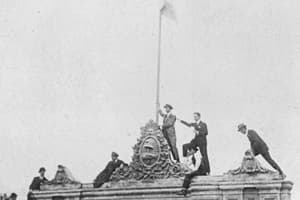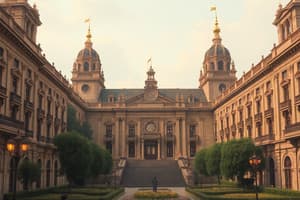Podcast
Questions and Answers
The Regulation approved in 1816 established the principle of compulsory ______.
The Regulation approved in 1816 established the principle of compulsory ______.
education
Canon Saturnino Segurola was appointed as the General Director of ______ by the City Council of Buenos Aires.
Canon Saturnino Segurola was appointed as the General Director of ______ by the City Council of Buenos Aires.
Schools
Schools in the countryside were supervised by Protective ______.
Schools in the countryside were supervised by Protective ______.
Boards
The Academy of Music was sponsored by the Governing Board beginning on ______ 18, 1810.
The Academy of Music was sponsored by the Governing Board beginning on ______ 18, 1810.
The Triumvirate decided to create a Medical ______ in May 1813.
The Triumvirate decided to create a Medical ______ in May 1813.
The educational reforms aimed to accentuate the scientific content of ______.
The educational reforms aimed to accentuate the scientific content of ______.
Teachers were advised to avoid mistreating children by ______.
Teachers were advised to avoid mistreating children by ______.
A patriotic nature was instilled by singing hymns of the ______ at the end of the school day.
A patriotic nature was instilled by singing hymns of the ______ at the end of the school day.
On December 11, 1821, the Police Chief was entrusted with the functions of the municipality, including those related to provincial __________.
On December 11, 1821, the Police Chief was entrusted with the functions of the municipality, including those related to provincial __________.
The incorporation of primary schools into the University of Buenos Aires helped recover the prestige that had been lost in recent __________.
The incorporation of primary schools into the University of Buenos Aires helped recover the prestige that had been lost in recent __________.
Dr. Antonio Sáenz was instrumental in improving education as he tirelessly visited schools to understand their needs and challenges in __________ education.
Dr. Antonio Sáenz was instrumental in improving education as he tirelessly visited schools to understand their needs and challenges in __________ education.
In June 1826, Rivadavia required that teachers prove their 'morality and intelligence in the mutual teaching __________.'
In June 1826, Rivadavia required that teachers prove their 'morality and intelligence in the mutual teaching __________.'
The rise of Rosas to power occurred on December 8, 1829, amidst significant internal __________.
The rise of Rosas to power occurred on December 8, 1829, amidst significant internal __________.
Rosas implemented a policy of social homogenization starting with __________, forcing alignment with the federal cause.
Rosas implemented a policy of social homogenization starting with __________, forcing alignment with the federal cause.
A decree in 1833 eliminated teacher salary, forcing parents to pay a fee for the __________ of the schools.
A decree in 1833 eliminated teacher salary, forcing parents to pay a fee for the __________ of the schools.
During Rosas's regime, basic education suffered significant setbacks due to the closure of many __________.
During Rosas's regime, basic education suffered significant setbacks due to the closure of many __________.
The Society of Welfare was forced to close its schools due to lack of ______.
The Society of Welfare was forced to close its schools due to lack of ______.
Intellectuals, educators, and artists considered ______ left Argentina seeking refuge.
Intellectuals, educators, and artists considered ______ left Argentina seeking refuge.
Esteban Echeverría and Domingo F. Sarmiento published numerous works on the tradition of ______.
Esteban Echeverría and Domingo F. Sarmiento published numerous works on the tradition of ______.
Marcos Sastre became Inspector General of Schools in ______, focusing on primary education.
Marcos Sastre became Inspector General of Schools in ______, focusing on primary education.
Sastre established requirements for teacher appointments, including ______, good behavior, and prior exams.
Sastre established requirements for teacher appointments, including ______, good behavior, and prior exams.
In urban schools, students received instruction in Christian doctrine and ______.
In urban schools, students received instruction in Christian doctrine and ______.
The Paraná College closed in ______ due to economic difficulties.
The Paraná College closed in ______ due to economic difficulties.
Esteban Echeverría began his studies in the College of ______ Sciences.
Esteban Echeverría began his studies in the College of ______ Sciences.
Flashcards are hidden until you start studying
Study Notes
Early Education in Argentina
- In 1821 the Police Chief was responsible for collecting provincial statistics, including educational data.
- University rectors, convent regents, and teachers in public and private schools were mandated to submit quarterly reports on student attendance.
- The University of Buenos Aires was established in 1821 and absorbed all public education, including elementary schools.
- Prior to the establishment of the University of Buenos Aires, primary education had experienced a decline in prestige.
- Antonio Sáenz, the University's first rector, actively visited schools to assess their needs, leading to significant expansion of elementary education.
- In 1826, Rivadavia implemented reforms, requiring teachers to demonstrate "morality and intelligence" in the mutual teaching system.
Rosas' Era (1829-1852)
- Rosas, who rose to power in 1829, implemented a policy of social homogenization, requiring educators to align with the federal cause.
- Many teachers were dismissed from their positions due to ideological differences.
- In 1832, all public employees, including school teachers, were required to wear a maroon emblem.
- Teacher salaries were eliminated in 1833, forcing parents to pay tuition fees.
- The closure of many schools and inadequate care of those remaining led to a significant decline in primary education.
Early Education Reforms
- In 1816, a regulation introduced compulsory education, with mayors and priests enforcing its implementation.
- This regulation defined the school curriculum and procedures, adjusting school vacations to coincide with agricultural tasks.
- Rural schools were supervised by Protective Boards, while city schools remained under the jurisdiction of the City Council.
- In 1817, Saturnino Segurola was appointed General Director of Schools.
- Segurola implemented reforms requiring teacher exams, discouraged corporal punishment, and enforced segregation based on race, reflecting ongoing prejudice from colonial times.
- Patriotism was integrated into school curriculum, including singing patriotic hymns and holding weekly gatherings at the Victory Plaza to celebrate the Fatherland.
The Academy of Music and the Medical Institute
- The Governing Board, formed in 1810, established the Academy of Music.
- The School of Mathematics, established in 1810 to educate young people for military service, functioned until 1812.
- The Triumvirate created a Medical Institute in 1813, guided by the plan of Doctor Cosme Argerich.
Education Under Rosas' Regime
- The Society of Welfare, a women's educational initiative, was forced to close due to financial constraints.
- Many intellectuals, educators, and artists considered liberal fled Argentina, seeking refuge in Uruguay, Chile, and Bolivia.
- Esteban Echeverría in Montevideo and Domingo F. Sarmiento in Chile became prominent advocates for education, publishing numerous works on the legacy of the May Revolution.
Educational Reforms in Entre Rios
- General Urquiza promoted primary education in Entre Ríos, entrusting its organization to Marcos Sastre.
- Sastre’s regulations clarified the functions of schools and teachers, emphasizing character development, ability enhancement, and abolishment of rewards and prizes
- Sastre established requirements for teachers, including Catholicism, good behavior, and prior aptitude exams.
- Educational content differed between urban and rural schools, with urban schools offering Christian doctrine, morality, reading, writing, arithmetic, and grammar. Rural schools focused on basic arithmetic.
- Urquiza established the College of Preparatory Studies in Paraná, later to be incorporated into the Concepción del Uruguay institution to form a national college, offering education to students from various provinces.
Esteban Echeverría: Political-Educational Thought of Argentine Romanticism
- Echeverría, who studied at the College of Moral Sciences, later obtained a broader education during his travels to Europe.
- Echeverría was influenced by Romantic literary currents prevalent in Europe.
Studying That Suits You
Use AI to generate personalized quizzes and flashcards to suit your learning preferences.




